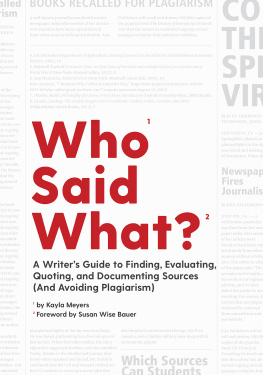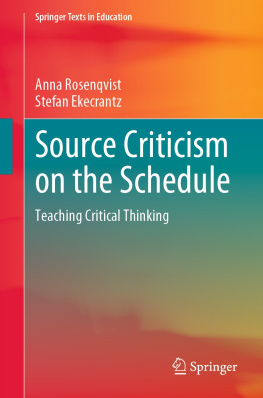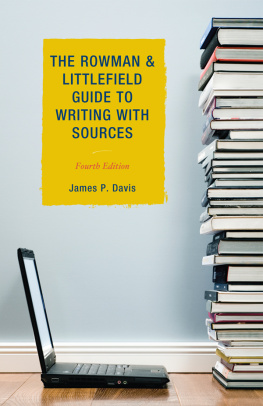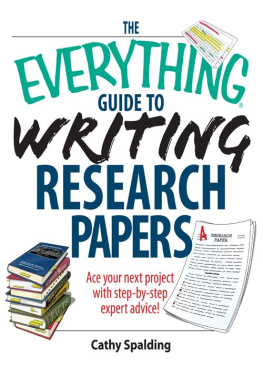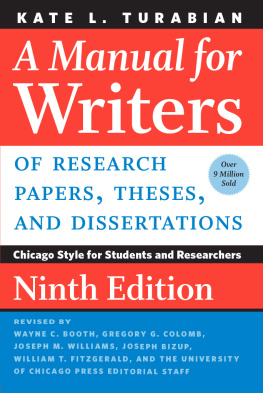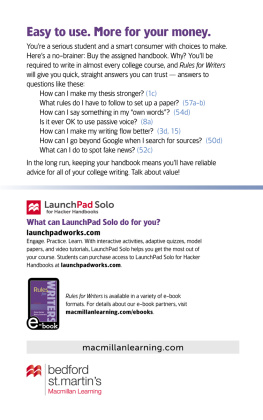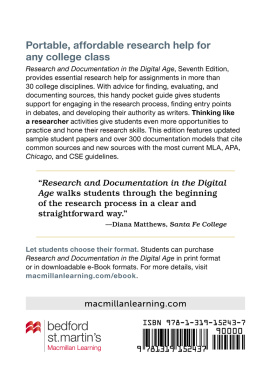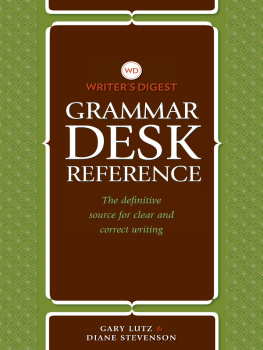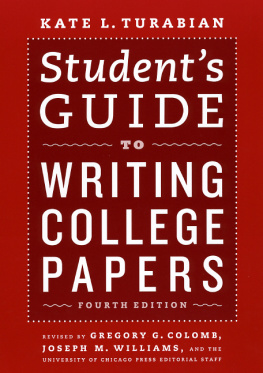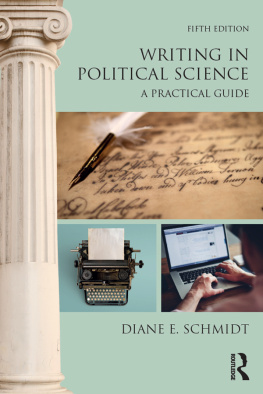Contents
Guide

Who
Said
What?
A Writers Guide to
Finding, Evaluating,
Quoting,
and Documenting
Sources (And Avoiding
Plagiarism)
Kayla Meyers
Foreword by Susan Wise Bauer

CONTENTS
Ive been a writing teacher for decades, and I can testify: Writing is an incredibly hard skill to teach, because writing is thinking. When youre putting your words down on paper, youre putting your mind down on paperand thats not a simple task.
When youre learning to write nonfiction essays and research papers, writing gets even more complicated. When youre writing well, youre not just setting down your thoughtsyoure reading, thinking, and synthesizing the ideas that other people have had, combining them with your own, and repeating their ideas but then building on them to come up with new ones.
And while youre doing all of that, you also have to worry about giving credit where credit is due. In todays wired world, it is simply too easy for writers (even experienced professionals, as Kayla Meyers deftly highlights in , How To Avoid Stealing) to accidentally plagiarize. Kayla recognizes this problem, and addresses it head-on with a set of practical suggestions, easily applied.
Ive watched hundreds of young writers struggle with the complicated, overlapping rules about documentationand often come to a dead stop because they simply cant get their heads wrapped around the problem. Who Said What? cuts right through the tangle, offering a clear, easy-to-follow set of principles. Not sure whether you need to footnote a statement or not? Kayla clears up the confusion. Not certain even how to footnote or endnote? Kaylas succinct directions will point you towards the answer. She walks students, step by step, through a process that is too often presented as overly complex: finding sources, taking notes, using those notes to construct a composition, and acknowledging where the ideas came from.
I first met Kayla when she began to teach writing for us at the Well-Trained Mind Academy, our classical online school. It was instantly clear that she had both rapport with her students, and a gift for straightforward, effective communication with them. She also grasped, very quickly, that they needed a simpler guide to the process of finding, using, and citing other authorities.
Kaylas experience as a young writer and teacher also highlighted something Id underestimated: students need to know what a reliable (authoritative, mediated, genuine, non-fake) source is . When I was a beginning writer, I could look to books and magazines for information. Now, students can glean information from thousands of websites, from audiovisual archives, from social media sites, and from other resources that simply didnt exist twentyor even fiveyears ago. Many of these sources are crowdsourced, semi-mediated, unmediated, or just plain deceptive. Kayla offers clear, simple advice about how to distinguish the reliable from the faulty, inaccurate, outdated, or even maliciously twisted. And she also gives invaluable guidance for incorporating insights from social media (ever present!) into legitimate research.
Working with the principles and rules set out in my full-year curricula Writing With Skill and Grammar for the Well-Trained Mind , while drawing on her own experience and expertise, Kayla has put together this invaluable handbook for the writer-in-training. Its more than a referenceits a quick-start guide for researchers, designed to get them reading and writing without delay.
Susan Wise Bauer
You can, of course, read this book straight through, for a full explanation of how and why these skills of finding the right sources, researching, note-taking, citation, and direct/indirect quoting all fit together. But if you are in a hurry, you can jump to the section that is most relevant to what you need (or what part of the research process you are stuck on).
At the end of each section, youll see a list of bullet-points summing up what youve just learned. At the end of each Part, there is a Quick Reference that lists all of the bullet-points from each section within. This Quick Reference provides a full summary of the Part.
Use these bullet-points to check your understanding after reading each section or Partor as a resource anytime you need a quick refresher on the material!
The Index at the end of the book is also a great resource to help you locate and review specific terms.
Part 1
What Sources Are, and Where to Find Them
A research paper just wouldnt be a research paper without a hearty band of sources to back it up. Sources are simply the books, articles, websites, images, videos, etc. that you find, read (or view), and then take notes from as you prepare to write. Sources provide the information that you will ultimately use to formulate your ideas and support your claims in your original writing. The types of sources you find and use will be determined by your teachers preferences and your paper requirements. But once youve decided on a clear, specific topic for your paper, finding sources is your next step.
Faced with a library of books, or even worse, the entire internet, you might find it difficult to know where to beginand what a reliable source even looks like. But dont panic! This guide will walk you through the process of finding reliable sourcesin a library or onlineand give you guidelines on how to sniff out any suspect information.
Sources provide reliable information that you will use to formulate your ideas and support your claims in a paper.
Sources can be books, articles, videos, website content, and any other medium that provides information related to your paper topic.
It would be great if you could perform a background check on every source and author you come across in your research! But that would be incredibly impractical, especially if youre on a tight paper deadline.
Instead, think of the information in your sources as fitting into two categories: mediated content and unmediated content .
Mediated content has been edited and fact-checked for general accuracy by a third party, generally one who has a financial or academic stake in the work. Essentially, mediated content is any work that has had more than one person review and edit the information. This increases the chance that the source is reliable.
Keep your critical glasses on: Mediated content can still be biased, inflammatory, or just plain wrong. But because it is mediated, it is appropriate to cite as a source in your paper.
Unmediated content travels directly from the originator to the reader, without any other person filtering or checking the information. Personal websites, for example, are unmediated. Only the author has looked over the content! When youre writing a paper, unmediated content is not appropriate to cite as a reliable source.
It was once easier to determine what sources fit into which category. Books, for example, were traditionally mediated by editors and publishers. However, it has become so easy to self-publish that you can no longer assume a book is mediated, simply because it has covers and bound pages. And while websites were once primarily unmediated, now many reputable academic journals publish their content solely online.
Instead, youll need to take on the responsibility of checking your sources closely to ensure that they contain mediated content.
Here are some questions to ask:
Does the source have a clear publisher other than the author?

